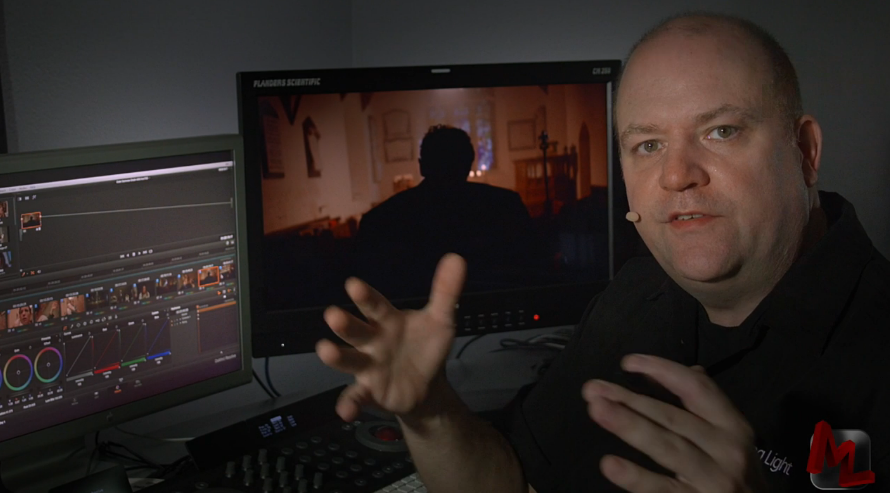DaVinci Resolve Tutorials To Improve Your Grades
Even though DaVinci Resolve 12 has been announced with lots of exciting features – check out this pretty epic post on it – there is still work to be done in the current version 11.3! That is until July when version 12 will drop. In the mean time, this round up of tips, tricks and tutorials should serve to teach you something new and improve your time spent in the colour grading suite as a result.
I thought I’d get started with something a little different and these 30 second tips from John Nierras on using a Wacom Cintiq with DaVinci Resolve providing an interesting insight into getting work done faster in Resolve. If you don’t have the £500-£2000/$600-$4000 for a Wacom Cintiq, these tips, based largely on the radial dial, will work with any Wacom tablet.
How-To Tutorials for DaVinci Resolve 11
If you’re new to DaVinci Resolve then Alexis Van Hurkman’s series of ‘Resolve in a Rush’ tips from Ripple Training are a great place to learn useful things in no time at all. If you like Alexis’ style it’s well worth checking out my review of his exhaustive training series for Resolve. Alexis also shared a really useful tip on the improved CinemaDNG debayering in the 11.2.1 release of Resolve, which, when you compare images side by side as Alexis does, looks much better as of 11.2.1.
If you open the CinemaDNG option of the Camera Raw panel of the Project Settings, you’ll see the following Camera Raw controls. The new features are the “Apply Pre Tone Curve” and “Apply Soft Clip” checkboxes.
In this tutorial from ICA colorist Warren Eagles you can learn how to conform a final edit from a client’s drive and copy it to your own fast storage media, with handles, via XML. This is called ‘Consolidate Clips’ and was added in the 11.2.1 version of Resolve. Handy to know!
Number 6 – Grade Bypass button. To the left, under the Node tree. Shift-D and Option-D toggles individual nodes or the whole tree on or off.
In this post titled “My Top 11 New Features in DaVinci Resolve 11“, from colorist and author Steve Hullfish you can learn several useful tips including how to create Powergrade albums to useful keyboard shortcuts and how to take advantage of new user interface improvements. A nifty and quick read.
Premiumbeat.com has recently posted a ton of really useful tips for improving your workflow in Resolve. Rather than explain each one here I thought I’d just post a collection of links as a speedy jumping off point. There are a lot more on the blog so check out the total list here.
How To Use Remote Grades in Resolve | Achieving Real Time Playback in Resolve | Tips on Pulling Better Keys | Grading with Multiple Split Screens | Using offline Reference Clips
For a really speedy tour of all the curves controls in Resolve, Theo from Meisner Media, blasts through everything you can do with them in under 10 minutes.
DaVinci Resolve Compositing Breakdown
In this detailed step by step compositing breakdown, Mike Wolf shares how he added an essential prop into a scene from a commercial, as well as some other set enhancements. It’s a great example of what can be achieved inside Resolve, if you know what you’re doing! H/T to Wolfcrow.com for the find.
Watching a Colorist At Work
If you’ve ever wondered what it’s like to physically sit-in with a colorist during a grading session then this hour long video from colorist David Torcivia is as close as you’re going to get to the real thing without climbing into his suite. What’s great about this video is that it is unedited, and that you can see down on to his colour grading panel as he works to see what he’s doing there too, as he updates some looks on a music video. David has previously posted another session to Youtube but as it doesn’t have his audio commentary on it, it’s not as instructive.
If you don’t have an hour to spare but you do have 15 minutes, there’s a lot of good stuff in this grading breakdown from David, on polishing a single shot from a music video.
Another great place to learn from professional colorists is subscription site MixingLight.com. This is a great investment for those who want to be professional colorists but might be overkill for those who are simply looking to learn a little more – although you would! Most of the content is behind the paywall, although you can take a complete access free 24 hour test drive, but every now and then a golden nugget is made available for free.
In this video tutorial, embedded over on Mixing Light.com, you can learn from colorist and trainer Patrick Inhofer, how to ‘see like your client’ and essentially offer them several different looks for the hero shots in your project, so that you can quickly narrow down what it is they’re specifically going for. A great insight into what’s available on Mixing Light.com and a great freebie!
DaVinci Resolve Workflow Tips
Polish colorist Tomasz Huczek recently posted a couple of useful step by step guides to a couple of common DaVinci Resolve workflows on his blog. The first explains the order of processing that occurs within a Resolve project (as described in the image above) and how adjustments effect other stages, which also sets the stage for understanding a grouped clip workflow.
Group Pre-Clip & Post-Clip – When a particular clip is assigned to any group then two additional options appear in the top-right popup menu. Group Pre-Clip nodes will be applied before any corrections in the clip section (the main section of every clip).
Post-Clip nodes will be applied after all the corrections made in the clip section.
Note: Caching doesn’t work on the group level so I don’t recommend using heavy processing in the group nodes as they will most likely sacrifice the performance of the playback.
The second workflow guide focuses on common issues that can occur when round tripping between Premiere Pro and Resolve. It’s also a handy guide for working with Magic Lantern RAW DSLR footage with a proxy workflow, including how to fix empty reel name metadata in Resolve and fix XML sub-clip issues from Premiere. Nice.
For FCPX user’s working with Resolve 11, you can learn a thing or two from Sam Mestman of FCPWorks fame, in this blog post in which he thoroughly tests an FCPX round trip workflow (in Resolve 11, so some of these things might have been fixed in subsequent versions). If you’re coming unstuck between FCPX and Resolve on a regular basis this will be worth a read!
Speed Change Roundtripping – If you see a speed change roundtrip into FCPX as a still frame… something weird happened, but your clip should actually be fine. In your roundtripped FCPX timeline, simply select the clip that is appearing as a still image and matchframe it. Your ins and outs should still be correct for the overall clips. Cut it back into your sequence, and just reapply your speed change, and things should be fine now (at least they were for me).
Editing in DaVinci Resolve
FCPX Trainer and editor Paul David Murray, recently shared these two tutorials on editing inside DaVinci Resolve ‘the FCP way’, which were re-posted on FCP.co with a bunch more valuable information here, including how to get a Retina Macbook Pro to play ball correctly. Paul takes you through the entire process in a detailed and methodical fashion. Paul ultimately concludes:
Having spent a couple of months playing with Da Vinci Resolve and its editing features it is blatantly obvious that who ever designed the editing functionality of Resolve was heavily influenced by Final Cut Pro. Editing in Resolve with FCP short cuts and logic is hardwired into the program and is not only very doable but can be actually very pleasurable. If you are coming from Final Cut Pro or Premiere for that matter, you should be able to take to it like a duck to water. Avid is not that far removed either!
LearnColorGrading.com – Free and Paid Tutorials
Alex Jordan is a DoP and the man behind learncolorgrading.com, a site which offers a series of free and paid tutorials for those looking to learn colour grading in Resolve in a hurry. In this interview with Curtis Judd, you can get a good understanding of what Alex has to offer, his opinion on some detailed colour grading topics and why his course’s conciseness is such an advantage. Here are some of the best tips from Alex’s Youtube channel.






